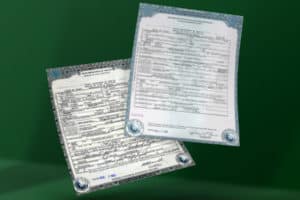For many people, embalming fluids aren’t a consideration until they are planning a loved one’s funeral and they see it on the itemized price list. It’s one of the most expensive aspects of traditional funerals, costing on average $775.
If you ask a funeral director about the necessity of embalming fluids you may get slightly varied responses depending on the director. All of them should tell you that using embalming fluids isn’t a requirement and there are alternatives that can be used. Some may tout the reasons for using it, and many won’t explain the harmful effects of using embalming fluids.
As an advocate for families, Cremation.Green strives to make all aspects of the funeral industry transparent and easily understood. In this post, we’re explaining how embalming fluids are used and alternative preservation methods that work just as well without the negative environmental impact.
The 3 Types of Embalming Fluids
There isn’t one single embalming fluid formula that’s used throughout the funeral industry. There are different types of embalming fluids that are used with different techniques and for different preservation purposes.
There are three primary types of embalming fluids:
Pre-Injections/Capillary Washes – Pre-injection fluids and capillary washes that are used prior to the actual embalming don’t have formaldehyde. The fluids go into the arterial system to prepare the body for embalming.
Arterial Embalming Fluids – Arterial embalming fluids range in firmness from hard (firming), medium firm, semi-firm, low firming to cosmetic.
Cavity Embalming Fluids – Cavity embalming fluids are notable for the smell or lack thereof. They can be regular fuming, low fume or odorless. There’s also non-irritant cavity embalming fluid.
Even within each type of embalming fluid there are different formulations. But one thing is the same with all types of embalming fluids. They contain highly toxic chemicals that aren’t good for the living. The chemicals can include:
Antibacterial Preservatives
Formaldehyde
Formalin (aqueous formaldehyde)
Glutaraldehyde
Phenol
Germicides
Quaternary Ammonium Compounds
Glutaraldehyde
Modifying Agents
Buffers
Humectants
Inorganic Salts
This is just a short list of the potential chemicals that can be in embalming fluids today. It’s no wonder that part of the reason the cost of embalming is so high is due to the potential risk of handling the chemicals.
The 4 Embalming Fluid Techniques
Embalming is a multi-stage process that takes anatomical understanding and expertise at using embalming equipment. Today four types of embalming techniques are regularly used. The first two embalming techniques, arterial and cavity embalming, are standard practice for every preservation. The other two techniques are used as needed once the arterial and cavity embalming are complete.
Arterial Embalming
The first step in the embalming process after capillary washing is arterial embalming. Embalming fluid is injected directly into blood vessels using an embalming machine. The embalmer must massage the embalming fluid through the body so that it’s distributed properly.
Cavity Embalming
Before cavity embalming, all of the fluids must be removed from the body. It’s replaced by the cavity embalming fluids. An aspirator and a medical device called a trocar are used to inject the embalming fluid into the cavities of the body.
Hypodermic Embalming
This is a fine tuning technique in which embalming fluid is injected just below the skin as needed. If the embalming fluid isn’t distributed evenly, hypodermic embalming is usually needed.
Surface Embalming
As the name suggests, this type of embalming is done at the skin level. It’s usually only needed if the person suffered visible trauma.
The 6 Healthy Embalming Alternatives
The fact that funeral homes have to take special protective measures when using embalming fluids tells you how harsh the substances are. There are actually a number of ways to embalm a body, and using embalming fluid is just one of the more modern approaches. Bodies began being preserved for funeral rituals thousands of years before embalming fluids were developed. Those early methods and some more current innovations are healthier alternatives that work just as well.
Healthier alternatives to embalming fluids include:
Refrigeration/Freezing
This is the most common alternative to embalming, and it is a method that is used at Cremation.Green. It’s the best option if cremation or burial will be delayed.
Dry Ice/Dry Cold
Dry ice is an effective way to preserve a body for a short period. It is commonly used for home funerals and green burials. Dry ice must be changed at least every 24 hours to properly preserve the body.
Dry Heat
Dry heat can be used to remove moisture and slow the decomposition process. It’s effective because both heat and dryness make it difficult for bacteria to grow. It’s believed that that hot, dry climate aided in early embalming in Egypt.
Sawdust Bed Mixed With Zinc Sulphate
A lesser known embalming alternative is to place the body in sawdust that is mixed with zinc sulphate.
Biodegradable Embalming Fluid
Now there is an option for embalming with formaldehyde-free embalming fluid. Typically biodegradable embalming fluid is made of essential oils. It’s effective for preservation, but only for a few weeks.
Direct Cremation
Families can also choose direct cremation for the disposition and bypass the need for embalming altogether. Direct cremation doesn’t involve funeral services at a funeral home. The family may hold a memorial service before the cremation, but most people choose to have a memorial after the cremation is done.
At Cremation.Green we never use toxic embalming fluids or any other harmful chemicals, instead opting for energy-efficient refrigeration. If you’d like to know more about green funeral services that are more affordable while being less impactful on the environment give our team a call, text or email any hour of the day.






